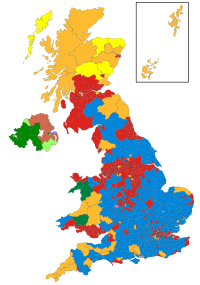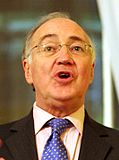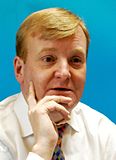
A | B | C | D | E | F | G | H | CH | I | J | K | L | M | N | O | P | Q | R | S | T | U | V | W | X | Y | Z | 0 | 1 | 2 | 3 | 4 | 5 | 6 | 7 | 8 | 9
| |||||||||||||||||||||||||||||||||||||||||||||||||||||
All 646 seats to the House of Commons 324 seats needed for a majority | |||||||||||||||||||||||||||||||||||||||||||||||||||||
|---|---|---|---|---|---|---|---|---|---|---|---|---|---|---|---|---|---|---|---|---|---|---|---|---|---|---|---|---|---|---|---|---|---|---|---|---|---|---|---|---|---|---|---|---|---|---|---|---|---|---|---|---|---|
| Opinion polls | |||||||||||||||||||||||||||||||||||||||||||||||||||||
| Registered | 44,245,939 | ||||||||||||||||||||||||||||||||||||||||||||||||||||
| Turnout | 61.4% ( | ||||||||||||||||||||||||||||||||||||||||||||||||||||
| |||||||||||||||||||||||||||||||||||||||||||||||||||||
 Colours denote the winning party, as shown in the main table of results. * Indicates boundary change – so this is a notional figure ‡ Figure does not include the Speaker, Michael Martin | |||||||||||||||||||||||||||||||||||||||||||||||||||||
 Composition of the House of Commons after the election | |||||||||||||||||||||||||||||||||||||||||||||||||||||
| |||||||||||||||||||||||||||||||||||||||||||||||||||||
The 2005 United Kingdom general election was held on Thursday 5 May 2005, to elect 646 members to the House of Commons. The governing Labour Party, led by Tony Blair, won its third consecutive victory, with Blair becoming the second Labour leader after Harold Wilson to form three majority governments. However, its majority fell to 66 seats; the majority it won four years earlier had been of 167 seats. This was the first time the Labour Party had won a third consecutive election. The Liberal Democrats won seats for the third time in a row, and scored the highest Liberal seat number since World War II. As of the 2024 general election this is the last Labour victory in a general election.
The Labour campaign emphasised a strong economy; however, Blair had suffered a decline in popularity, which was exacerbated by the decision to send British troops to invade Iraq in 2003. Despite this, Labour mostly retained its leads over the Conservatives in opinion polls on economic competence and leadership, and Conservative leaders Iain Duncan Smith (2001–2003) and Michael Howard (2003–2005) struggled to capitalise on Blair's unpopularity, with the party consistently trailing behind Labour in the polls throughout the 2001–2005 parliament.[1]
The Conservatives campaigned on policies such as immigration limits, improving poorly managed hospitals, and reducing high crime rates. The Liberal Democrats, led by Charles Kennedy, took a strong stance against the Iraq War, particularly due to the absence of a second UN resolution,[2] This anti-war position resonated with disenchanted Labour voters,[3] leading to the Liberal Democrats achieving their largest share of seats in the party's history.
Blair was returned as Prime Minister, with Labour having 355 MPs, but with a popular vote share of 35.2%, the smallest of any majority government in UK electoral history. In terms of votes Labour was only narrowly ahead of the Conservatives, but the party still held a comfortable lead in terms of seats. The Conservatives returned 198 MPs, with 32 more seats than they had won at the previous general election, and won the popular vote in England, while still ending up with 91 fewer MPs in England than Labour. The Liberal Democrats saw their share of the popular vote increase by 3.7%, and won the most seats of any third party since 1923, with 62 MPs. Anti-war activist and former Labour MP George Galloway was elected as the MP for Bethnal Green and Bow under the Respect – The Unity Coalition banner, unseating Oona King; Richard Taylor was re-elected for Kidderminster Health Concern in Wyre Forest; and independent candidate Peter Law was elected in Blaenau Gwent.[4]
This is the most recent general election in which the winning political party won a majority of the seats that were contested in each of the constituent countries of Great Britain (i.e. England, Scotland and Wales) at the same time.
In Northern Ireland, the Ulster Unionist Party (UUP), the more moderate of the main unionist parties, which had dominated Northern Irish politics since the 1920s, was reduced from six MPs to one, with party leader David Trimble himself being unseated. The more hardline Democratic Unionist Party became the largest Northern Irish party, with nine MPs elected.
Apart from Trimble, notable MPs leaving the House of Commons at this election included former SDLP leader John Hume, former Cabinet ministers Estelle Morris, Paul Boateng, Chris Smith, Gillian Shephard, Virginia Bottomley and Michael Portillo, the Father of the House of Commons Tam Dalyell, Tony Banks and Sir Teddy Taylor, while Stephen Twigg (see Portillo moment) lost the Enfield Southgate constituency back to the Conservatives. A notable MP who joined the House of Commons at this election was future Labour leader Ed Miliband.
Following the election, Michael Howard conceded defeat, resigned as Conservative leader and was succeeded by future prime minister David Cameron. Blair resigned as both prime minister and leader of the Labour Party in June 2007, and was replaced by then–Chancellor of the Exchequer Gordon Brown. The election results were broadcast live on the BBC and presented by Peter Snow, David Dimbleby, Tony King, Jeremy Paxman, and Andrew Marr.
Overview
The governing Labour Party, led by Tony Blair, was looking to secure a third consecutive term in office and to retain a large majority. The Conservative Party was seeking to regain seats lost to both Labour and the Liberal Democrats since the 1992 general election, and move from being the Official Opposition into government. The Liberal Democrats hoped to make gains from both main parties, but especially the Conservative Party, with a "decapitation" strategy targeting members of the Shadow Cabinet. The Lib Dems had also wished to become the governing party, or to make enough gains to become the Official Opposition, but more realistically hoped to play a major part in a parliament led by a minority Labour or Conservative government. In Northern Ireland the Democratic Unionist Party sought to make further gains from the Ulster Unionist Party in unionist politics, and Sinn Féin hoped to overtake the Social Democratic and Labour Party in nationalist politics. (Sinn Féin MPs do not take their seats in the House of Commons—they follow a policy of abstentionism.) The pro-independence Scottish National Party and Plaid Cymru (Party of Wales) stood candidates in every constituency in Scotland and Wales respectively.
Many seats were contested by other parties, including several parties without incumbents in the House of Commons. Parties that were not represented at Westminster, but had seats in the devolved assemblies and/or the European Parliament, included the Alliance Party of Northern Ireland, the UK Independence Party, the Green Party of England and Wales, the Scottish Green Party, and the Scottish Socialist Party. The Health Concern party also stood again. A full list of parties which declared their intention to run can be found on the list of parties contesting the 2005 general election.
All parties campaigned using such tools as party manifestos, party political broadcasts and touring the country in what are commonly referred to as battle buses.
Local elections in parts of England and in Northern Ireland were held on the same day. The polls were open for fifteen hours, from 07:00 to 22:00 BST (UTC+1). The election came just over three weeks after the dissolution of Parliament on 11 April by Queen Elizabeth II, at the request of the Prime Minister, Tony Blair.
Campaign
Following the death of Pope John Paul II on 2 April, it was announced that the calling of the election would be delayed until 5 April.[5]
Thanks to eight years of sustained economic growth Labour could point to a strong economy, with greater investment in public services such as education and health. This was overshadowed, however, by the issue of the controversial 2003 invasion of Iraq, which met widespread public criticism at the time, and would dog Blair throughout the campaign. The Chancellor, Gordon Brown, played a prominent role in the election campaign, frequently appearing with Blair and ensuring that the economy would remain the central focus of Labour's message.
Recently elected Conservative leader Michael Howard brought a great level of experience and stability to a party that had ousted its former leader Iain Duncan Smith[6] just 18 months prior. The Conservative campaign was managed by Australian strategist Lynton Crosby.[7] The campaign focused on more traditional conservative issues like immigration, which created some controversy with the slogan "It's not racist to impose limits on immigration".[8] They also criticised Labour's "dirty" hospitals and high crime levels, under the umbrella of the slogan "Are you thinking what we're thinking?"[9]
However, Labour counter-attacked, by emphasising Howard's role in the unpopular Major Government of 1992–1997, airing a party election broadcast attacking Howard, showing a montage of scenes from Howard's tenure as Home Secretary, including prison riots and home repossessions. It also launched a billboard campaign showing Howard, and the Conservative Party's four previous leaders (Iain Duncan Smith, William Hague, John Major and Margaret Thatcher), with the caption "Britain's working, don't let the Tories wreck it again."[10]
For the Liberal Democrats, this was the second and final election campaign fought by leader Charles Kennedy, who strongly opposed the Iraq War and personally offered a more down-to-earth approach to voters, which proved popular. There were some questions, however, over Kennedy's abilities when, at the Liberal Democrat manifesto launch, he was asked about local income tax, but appeared confused on the figures.[11] Both the Liberal Democrats and the Conservatives were keen to tackle Labour's introduction of tuition fees, which both opposition parties opposed and promised to abolish.[12]
Ballot

At the close of voting (2200 BST) the ballot boxes were sealed and returned to the counting centres, where counting proceeded under the supervision of the returning officer who was obliged to declare the result as soon as it was known. As previously, there was serious competition amongst constituencies to be first to declare. Sunderland South repeated its performance in the last three elections and declared Labour incumbent Chris Mullin re-elected as MP with a majority of 11,059 at approximately 2245 BST (failing by two minutes to beat its previous best, but making it eligible for entry into the Guinness Book of World Records as longest consecutive delivery of first results). The vote itself represented a swing (in a safe Labour seat, in a safe Labour region) of about 4% to the Conservatives and 4.5% to the Liberal Democrats, somewhat below the prediction of BBC/ITV exit polls published shortly after 2200 BST.
Sunderland North was the next to declare, followed by Houghton and Washington East, both of whose Labour MPs retained their seats but with reductions in the incumbent majorities of up to 9%. The first Scottish seat to declare was Rutherglen and Hamilton West — another safe Labour seat, also a Labour hold, but with the majority reduced by 4%. The first seat to change hands was Putney, where Labour's majority of 2,771 fell to a strong Conservative challenge, with a total swing of about 5,000 (6.2%). This was also the first seat to be declared for the Conservatives. The first Liberal Democrat seat to be declared was North East Fife, the constituency of Lib Dem deputy leader Sir Menzies Campbell which he had held since 1987.
The constituency of Crawley in West Sussex had the slimmest majority of any seat, with Labour's Laura Moffatt holding off the Conservatives' Henry Smith by 37 votes after three recounts.
Polling
| Opinion polling for UK general elections |
|---|
| 1997 election |
| Opinion polls |
| 2001 election |
| Opinion polls |
| 2005 election |
| Opinion polls |
| 2010 election |
| Opinion polls |
| 2015 election |
| Opinion polls • Leadership approval |
Following problems with exit polls in previous British elections, the BBC and ITV agreed for the first time to pool their respective data, using results from Mori and NOP. More than 20,000 people were interviewed for the poll at 120 polling stations across the country. The predictions were very accurate—initial projections saw Labour returned to power with a majority of 66 (down from 160),[13] and the final result (including South Staffordshire, where the election was postponed due to the death of a candidate) was indeed a Labour majority of 66.
The projected shares of the vote in Great Britain were Labour 35% (down 6% on 2001), Conservatives 33% (up 1%), Liberal Democrats 22% (up 4%) and other parties 8% (up 1%).[13] The Conservatives were expected to make the biggest gains, however — 44 seats according to the exit poll — with the Liberal Democrats expected to take as few as two. While the Lib Dems' vote share predicted by the exit poll was accurate (22.6% compared to the actual 22.0%), they did better in some Lib Dem-Labour marginals than predicted on the basis of the national share of the vote, and achieved a net gain of 11 seats.
2001 notional result
There were major boundary changes in Scotland, where the number of seats was reduced from 72 to 59. As a result of this each party lost some seats, and this notional election result below is based on the 2001 election results if they had been fought on these new 2005 boundaries.
| Party | Seats | Gains | Losses | Net gain/loss | Seats % | Votes % | Votes | +/− | |
|---|---|---|---|---|---|---|---|---|---|
| Labour | 403 | 2 | 8 | -6 | 62.38 | 40.7 | 10,724,953 | ||
| Conservative | 165 | 9 | 8 | +1 | 25.54 | 31.7 | 8,357,615 | ||
| Liberal Democrats | 51 | 8 | 2 | +6 | 7.89 | 18.3 | 4,814,321 | ||
| SNP | 4 | -1 | 0.62 | 1.8 | 464,314 | ||||
| Other parties | 23 | 3.57 | 7.5 | ||||||










